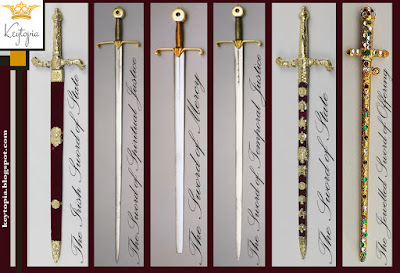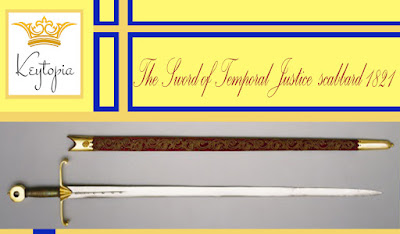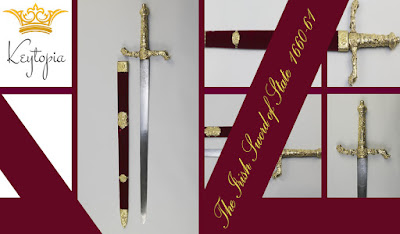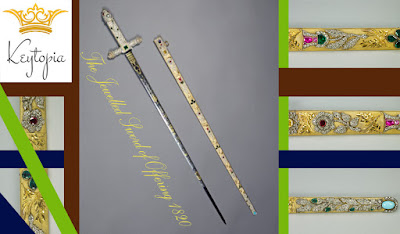The Beauty 6 Swords of The Crown Jewel British Kingdom
The sword is a historical object is valuable and often we meet in legends or mythologys on a story.
Every Knight at the time of the old Kingdom or republic has a sword that is always used in a battle or war.
Historically, the sword developed in the bronze age. The first weapon that could be described as ' sword ' dates to about 3300 BC found at Arslantepe, Turkey is the oldest sword made from the bronze of arsenic and its length of about 60 cm (24 in). Some swords were found decorated with silver.
If talking about the sword, our focus is not just about the sharpness of a sword. However, we also see the other side as the history, legends and the beauty of the ornaments on sword, such as the legendary sword embedded in stone's “Excalibur”.
The function of the Sword is not only used as a symbol in the wars or fights. The sword was also used as the symbol of the coronation of the King's coronation.
Crown Jewel of the British Kingdom has 6 swords that became a symbol of British country included in the 141 historic ceremonial objects, including regalia and robes worn by Kings and Queens of the country while the coronation and anointing processions and objects, plates, and the baptismal font.
What are the 6 Crown Jewel sword British Kingdom. This list belong:
| 1 | The Sword of Spiritual Justice early seventeenth century 1626 |
|---|
Characteristics of the sword of Spiritual Justice early seventeenth century
The Sword of Spiritual Justice early seventeenth century was a sword with a size 116.8 x 99.7 cm from the object consists of material throughout the iron, steel, copper, gold, silver, wood, leather, velvet, which is then compiled into a sword.On the hilt of the sword has a gold-iron with a handle of wood, wire-bound, in triangular shaped sword escutcheons rather sharply pointed downward, with a steel blade. At the top it has the mark of the maker, putting further down with “running wolf” mark.
Scabbard The Sword of Spiritual Justice early seventeenth century made of velvet covered with gold and silver embroidery-gold mountain. With motifs resembling leaves.
The makers of the sword of Spiritual Justice early seventeenth century
The makers of the sword of Spiritual Justice early seventeenth century is the bladesmith Zandona Ferrara (active c. 1600) and collaborated with the royal goldsmiths Rundell Bridge&Rundell.The history of the Sword of Spiritual Justice early seventeenth century
The Sword of Spiritual Justice early seventeenth century or also known as The Sword of Justice to the Clergy or the Kirk men is one of three swords drawn done, pointing to the top, in the coronation procession.At the time of the coronation procession of The Sword of Spiritual Justice early seventeenth century accompanied by The Sword of Temporal Justice and The Sword of Mercy the early seventeenth century.
The practice of bringing three swords, representing the virtues of Kings, dates back to the coronation of Richard the Lion heart in 1189-1199, he ruled the United Kingdom within only a short time (10 years).
Richard the Lion heart was one of the very deserved to be discussed in any discussion of the crusade who was born with the surname Richard Plantagenet in Oxfordshire United Kingdom on September 8th, 1157 and died due to the infection of the wound by arrow April 6th 1199 at Chalus.
The Sword of Spiritual Justice early seventeenth century was one of Three that was the sword that was made for the coronation of Charles I (1600-1649) in 1626 and then placed with the regalia in Westminster Abbey. Together with the coronation spoon, these three works are the only fruit to survive the civil war and Interregnum untouched.
It is not known whether they were used in the coronation procession of Charles II (1630-1685), but Three of the sword must have been used since 1685. A new Holster made for the sword in 1821 for the coronation of George IV (1762-1830).
| 2 | The Sword of Mercy early seventeenth century 1626 |
|---|
The characteristics of The Sword of Mercy early seventeenth century
The Sword of Mercy early seventeenth century 96.5 x has a length of 19 cm in the entire object with a material steel, iron, copper, wood, leather gloves, velvet, gold, silver.The Sword of Mercy early seventeenth century gold-iron have a handle with wood, wire-bound grip, and a large steel blade on the tip of the sword cut of about 2.5 cm from the starting point, with “Running Wolf” mark ornamental in copper; leather gloves with velvet covered with gold and silver embroidery-gold mountain. With motifs resembling leaves.
The makers of The Sword of Mercy early seventeenth century
The makers of the sword, The Sword of Mercy early seventeenth century is the bladesmith Zandona Ferrara (active c. 1600) and collaborated with the royal goldsmiths Rundell Bridge&RundellThe history of The Sword of Mercy early seventeenth century
The Sword of Mercy early seventeenth century or commonly known with The Curtana is one of three swords drawn done, pointing to the top, in the coronation procession. This sword is accompanied by two swords of Justice.The practice of bringing three swords, representing the virtues of Kings, dates back to the coronation of Richard the Lion heart in 1189. This sword, who represents Mercy, has had its end removed so that it no longer functioned as a weapon, though the original was built in the same way as practical sword.
There is an interesting Legend from The Sword of Mercy early seventeenth century that is legends that come from Henry III.
The Sword of Mercy early seventeenth century Curtana sword said to have legendary Knight Tristan. This connection may occur due to the broken ends such as the Tristan is said to have left a piece of his skull in the Morholt.
A sword named “Cortana”, etc., the Curtana is also associated with Ogier Dane, one of Emperor Charlemagn's paladins in France. According to legend, he bore the inscription “my name is Cortana, of the same steel and temper as Joyeuse and Durendal” and when the child is about to kill Charlemagne Ogier, an angel appeared and knocked out of his hands, breaking the end and cried out “Mercy is better than revenge!” In the 13th century The Prose Tristan declares that succeeded to the Ogier sword Tristan, shortening and naming it Cortaine, it shows the author knew the tradition connecting Henry Curtana to Tristan.
The Sword of Mercy early seventeenth century with two swords made for the coronation of Charles I in 1626 and then placed with the regalia in Westminster Abbey.
Together with the coronation spoon, these three works are the only fruit to survive the civil war and Interregnum untouched. It is not known whether they were used in the coronation procession of Charles II, but they certainly have been used since 1685. A new Holster made for the sword in 1821 for the coronation of George IV.
| 3 | The Sword of Temporal Justice scabbard: 1821 |
|---|
Characteristics of The Sword of Temporal Justice
The Sword of Temporal Justice has length 116.5 x 99.3 cm (all objects) with and composed of iron, steel, copper, wood, leather, velvet, gold, silver.The Sword of Temporal Justice has gold-iron with a handle of wood, wire-bound grip, steel tapered blade to the point of leaf-shaped symbols such as stamped on the open gutter lozenges with the name of the maker.
On scabbard made from velvet closed leather sheath with embroidered gold and silver-gold mountain. Leaf motive.
The makers of The Sword of Temporal Justice
The makers of the sword of Temporal Justice is the blade smith Zandona Ferrara (active c. 1600) and collaborated with the royal goldsmiths Rundell Bridge&RundellThe history of The Sword of Temporal Justice
This sword, known as the sword of Temporal Justice, is one of three swords drawn done, pointing to the top, in the coronation procession.This sword is accompanied by the sword of Spiritual Justice and the sword of Mercy (with blunt tip). The practice of bringing three swords, representing the virtues of Kings, dates back to the coronation of Richard the Lion heart in 1189.
The three swords are made for the coronation of Charles I in 1626 and then placed with the regalia in Westminster Abbey. Together with the coronation spoon, these three works are the only fruit to survive the civil war and Interregnum untouched.
It is not known whether they were used in the coronation procession of Charles II, but they certainly have been used since 1685. A new Holster made for the sword in 1821 for the coronation of George IV.
4 | The Irish Sword of State 1660-61 |
|---|
Characteristics of The Irish Sword of State
The Irish Sword of State and have steel, gold, silver, wood, velvet glovesThis sword has a wide, straight, flat, double-edged steel blade with engraved decoration, and the handle of a silver-Gold cross, which is in the form of a lion rampant quillons and unicorn, quillon block in front of the harp and the bars on the top.
Wooden scabbard covered in velvet with silver-gold emblems are applied including rose, thistle and coat of arms from the period 1714-1801.
The makers of The Irish Sword of State
The maker of The Irish Sword of State was William King bladesmith with collaborating with the creation of the Golden George Bowers (active 1660)History of The Irish Sword of State
The Irish Sword of State or known as The King's (Queen's) Sword retrieved during the reign of Charles II, King of the United Kingdom (1630-1685).This sword was used to represent the State when he was absent physically, as a symbol of Royal authority. This example was used by the Lord Lieutenant of Ireland as Vice sultan and incurred by him on state occasions. It was supplied to the Lord Lieutenant in 1660, though its scabbard dated from a period later.
Ireland's sword of State was used until the establishment of the free State of Ireland in 1922, and stored in Dublin until that date. It was added to the regalia in the Jewel House in 1959.
5 | The Sword of State 1649-98 |
|---|
Characteristics of The Sword of State
The Sword of State have long 121.3 x 32.1 cm from the entire object that consists of the material steel, gold, silver, wood, velvet glove. With a weight of 83 oz sword and scabbard 34 oz.This sword has a wide, straight, flat, double-edged steel blade with engraved decoration, and the handle of a silver-Gold cross, which is in the form of a lion rampant quillons and the unicorn, a fleur-de-lis quillon block and in front of the Tudor Rose on the back, with the sliding doors above.
Wooden scabbard covered in velvet with silver-gold emblems are applied including a rose, thistle, harp and fleur-de-lis, with sliding doors, a Royal lion and the coat of arms of William III.
The makers of The Sword of State
The makers of The Sword of State is defined gold George Bowers (active 1660)History of The Sword of State
This sword, known as the sword of State, traditionally used by the monarchy after the coronation, in place of the sword Deals (that is stored with the regalia of the Abbey), for all official occasions, when it will be done before the sultan.The handle of the sword and a decorative emblem on the Holster that it intended to do with the point upwards. Two sword of State was made for Charles II-the first in 1660, and this one in 1678. It is described as 'a new sword, the most incredible Estate wrought enchased and gold'. 1660 sword used when Charles II attended the Parliament, and this example is used on official occasions such as the creation of ceremonial Knights of the Bath.
The Holster carries the coat of arms of William III and the date of his coronation. 1660 sword no longer exists but this one remains among the regalia at the Tower of London. It is still used occasionally by the Queen for events such as the coronation of the Prince of Wales in 1969 and VE day service at St Paul's Cathedral in 1995.
The Jewelled Sword of Offering 1820 RCIN 31726
6 | The Jewelled Sword of Offering 1820 |
|---|
Characteristics of The Jewelled Sword of Offering
The Jewelled Sword of Offering has a length of 88.4 cm with Scabbard length: 89.5 cm. Which is considered the most beautiful and precious sword in the world. With the cost of making £5.988, and serves the jewels of all colors is set in gold. With a total of 3,476 precious stones.The Jewelled Sword of Offering consists of Gold material, blued steel and gold, silver, diamonds, rubies, emeralds. Glove leather, gold, diamonds, rubies, emeralds, sapphires, turquoise, lined in silk velvet.
The sword has a straight, narrow, sharp tapered steel blade partially blued and gilt, decorated on both faces with the national coat of arms (rose, thistle and shamrock) between win dings strap work, the Royal coat of arms, Royal Crown with GR monogram and a WR monogram then, trophy weapons, and figures of Britannia.
Gold cross handles have short, straight quillons ending in lion masks and Chase cast, solid overall set with diamonds, with the eyes of ruby-set; rectangular block with a quillon, with a large Center Emerald on each side-in the front of the rectangular stone, behind one of the octagonal, both framed in diamonds.
Straight grip set with diamond spray oak, with Emerald seed; and hit a set with diamonds, with a central Emerald on each side and four rubies at the end. Leather gloves are fully wrapped in sheets and covered with red silk velvet.
The Holster is pursued with the rose, thistle and shamrock, set with emeralds, rubies and diamonds, with a similar design is pursued instead, crumpled on the ground; mouth-pendant mounted with Sapphire and ruby. Chape decorated with a spray of oak leaves diamond with Emerald and turquoise large seeds on each side.
The makers of The Jewelled Sword of Offering
The design of The Jewelled Sword of Offering was suggested by George IV, and made by the royal goldsmiths Rundell Bridge&RundellHistory of The Jewelled Sword of Offering
The Jewelled Sword of Offering was used as a sword is offering it in Coronation of George IV (1762-1830) in 1821. With a tradition of Sword Supply maintained by the rulers after the coronation, and this example is not used again until 1902 coronation ceremony on when it was used by Edward VII, and it was on this date that join it regalia at the Tower of London. It has been used as a sword Offers in every subsequent coronation.Swords Deals is one of the things that the sovereign was invested during the coronation ceremony. This happened after the anointing, when sultan then cloaked and served with a number of symbolic ornaments. Many of these relate to the Knight of virtue. Archbishop blessed the sword and then gave it to the King with the command that should be used for the protection of the good and the punishment of crime.
The sword was later offered upon the altar. After the coronation of the sultan, was then crowned.
Thus was the beauty of the 6 Swords Crown Jewel British Kingdom hopefully be able to add insight knowledge.
For the 6 Swords Crown Jewel of British Kingdom stored in the Tower of London, which is located at St Katharine's and Wapping, London EC3N 4AB, United Kingdom you can visit on a Monday - Saturday: 09:00 to 16:30 and Sunday - Monday: 10:00 to 16:30 please visit and do not forget bring your family, friends, and couples.
Reference
Wikipedia, Royal Collection Trust
The Beauty 6 Swords of The Crown Jewel British Kingdom
 Reviewed by Unknown
on
3/16/2017
Rating:
Reviewed by Unknown
on
3/16/2017
Rating:
 Reviewed by Unknown
on
3/16/2017
Rating:
Reviewed by Unknown
on
3/16/2017
Rating:









No comments: